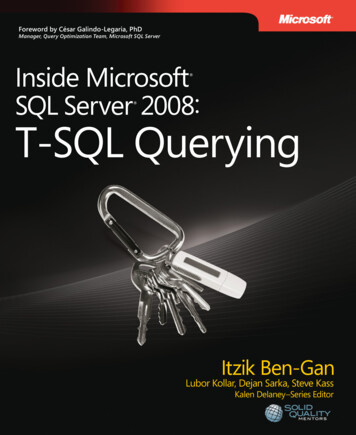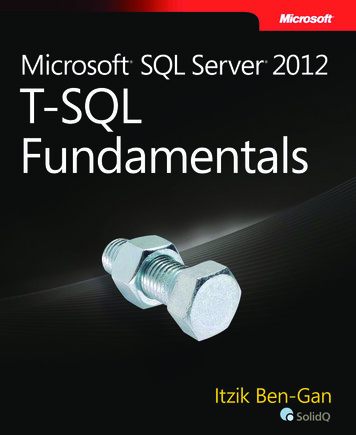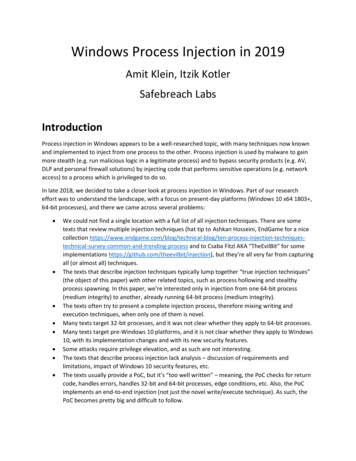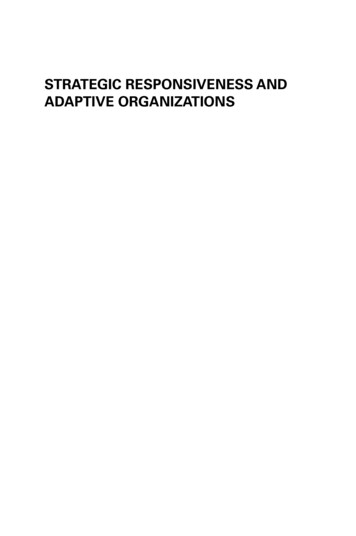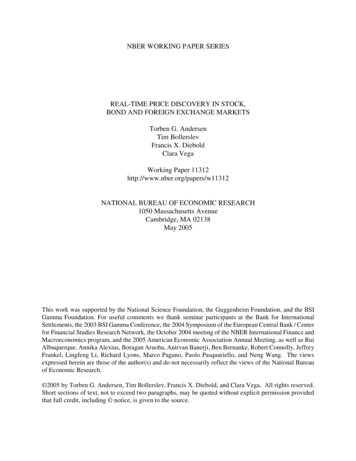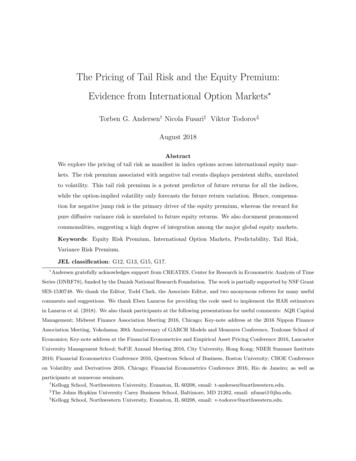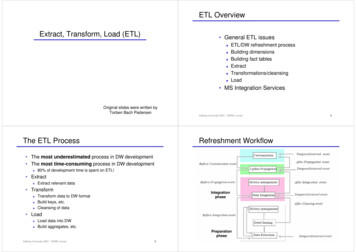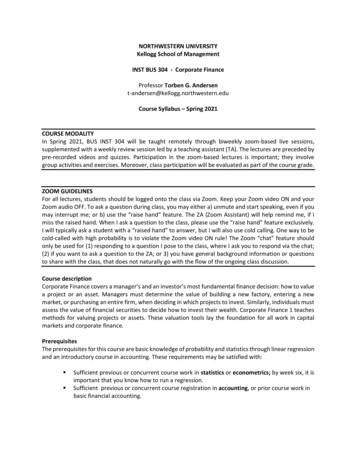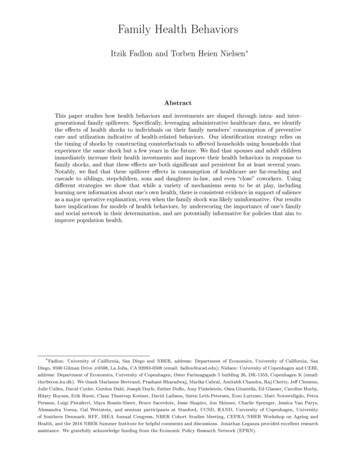
Transcription
Family Health BehaviorsItzik Fadlon and Torben Heien Nielsen AbstractThis paper studies how health behaviors and investments are shaped through intra- and intergenerational family spillovers. Speci cally, leveraging administrative healthcare data, we identifythe e ects of health shocks to individuals on their family members' consumption of preventivecare and utilization indicative of health-related behaviors.Our identi cation strategy relies onthe timing of shocks by constructing counterfactuals to a ected households using households thatexperience the same shock but a few years in the future. We nd that spouses and adult childrenimmediately increase their health investments and improve their health behaviors in response tofamily shocks, and that these e ects are both signi cant and persistent for at least several years.Notably, we nd that these spillover e ects in consumption of healthcare are far-reaching andcascade to siblings, stepchildren, sons and daughters in-law, and even close coworkers.Usingdi erent strategies we show that while a variety of mechanisms seem to be at play, includinglearning new information about one's own health, there is consistent evidence in support of salienceas a major operative explanation, even when the family shock was likely uninformative. Our resultshave implications for models of health behaviors, by underscoring the importance of one's familyand social network in their determination, and are potentially informative for policies that aim toimprove population health. Fadlon: University of California, San Diego and NBER, address: Department of Economics, University of California, SanDiego, 9500 Gilman Drive #0508, La Jolla, CA 92093-0508 (email: fadlon@ucsd.edu); Nielsen: University of Copenhagen and CEBI,address: Department of Economics, University of Copenhagen, Øster Farimagsgade 5 building 26, DK-1353, Copenhagen K (email:thn@econ.ku.dk). We thank Marianne Bertrand, Prashant Bharadwaj, Marika Cabral, Amitabh Chandra, Raj Chetty, Je Clemens,Julie Cullen, David Cutler, Gordon Dahl, Joseph Doyle, Esther Du o, Amy Finkelstein, Osea Giuntella, Ed Glaeser, Caroline Hoxby,Hilary Hoynes, Erik Hurst, Claus Thustrup Kreiner, David Laibson, Søren Leth-Petersen, Erzo Luttmer, Matt Notowidigdo, PetraPersson, Luigi Pistaferri, Maya Rossin-Slater, Bruce Sacerdote, Jesse Shapiro, Jon Skinner, Charlie Sprenger, Jessica Van Parys,Alessandra Voena, Gal Wettstein, and seminar participants at Stanford, UCSD, RAND, University of Copenhagen, Universityof Southern Denmark, RFF, IHEA Annual Congress, NBER Cohort Studies Meeting, CEPRA/NBER Workshop on Ageing andHealth, and the 2016 NBER Summer Institute for helpful comments and discussions. Jonathan Leganza provided excellent researchassistance. We gratefully acknowledge funding from the Economic Policy Research Network (EPRN).
1 IntroductionHealth behaviors, broadly de ned as any action, investment, or consumption choice that can a ecthealth and mortality risk, are a key input in the production of individuals' health. These behaviorstake a variety of forms including both adverse habits, such as smoking and drinking, and positiveactions, such as the consumption of risk-reducing preventive care.A long tradition of economic research has underscored the importance of family interactions indetermining individual behavior, particularly in the context of sharing nancial resources for the consumption of goods and of labor supply choices.Similarly, there is a potentially signi cant role forthe family in forming health behaviors over the natural course of the life cycle, through a variety ofchannels such as the ow of information, attention and awareness, belief formation, and norms. Yet,identifying causal relationships of family spillovers that can a ect health behaviors is challenging dueto the possibility of correlated unobservables across and within generations of the family. Moreover, itrequires large data sets on health and consumption of healthcare with linkages across family members.In this paper, we study how health behaviors are shaped through family spillovers both withinand across generations.Speci cally, we estimate the causal e ects of health shocks to individualson their family members' consumption of preventive care and utilization indicative of health-relatedbehaviors, focusing on spouses and adult children.Our estimation strategy relies on the timing ofshocks, by constructing counterfactuals to a ected households using households that experience thesame shock but a few years in the future. To do so, we leverage a long panel of administrative data withcomprehensive and detailed information on health and healthcare utilization. The data, which cover theentire adult Danish population from the years 1980-2011, include all medication prescriptions, contactswith primary-care physicians and medical-care specialists, inpatient and outpatient hospitalizations,and death records. An important advantage of our setting is the combination of large-scale objectivehealth information with the ability to link across di erent circles of one's family and social network.Exploiting these di erent layers of family and social connections further enables us to investigate thescope of health behavior spillovers within one's network.Put together, our ndings identify intra- and inter-generational family spillovers as a prevalentcausal channel through which health behaviors evolve. Spouses and adult children immediately increasetheir health investments and improve their health behaviors in response to shocks.We show thatthese e ects are both economically signi cant and exhibit a high degree of persistence. We nd thatthese spillovers in consumption of healthcare are far-reaching across one's network with a meaningfulimplied multiplier: the e ects cascade to siblings, stepchildren, sons and daughters in-law, and even close coworkers, who exhibit responses of the same order of magnitude as spouses.Notably, weare additionally able to show that this is likely where they approach their limit, as there are noe ects (precisely estimated) on distant coworkers with likely weaker social ties. Overall, our analysisreveals spillovers in consumption within the context of healthcare that are signi cant in magnitude,far-reaching, and long-lasting.Besides the implications for the spillovers' breadth, studying the di erent layers of one's networkallows us to probe into mechanisms, as di erent network members are subject to di erent sets ofchannels. We conceptualize two major classes of mechanisms by which network shocks can draw one's1
attention and trigger changes in health behaviors.lation of new information that pertains to one'sThe rst channel is potential learning and reve-ownrisk. This could work through an exogenous informational shock, as in the case of biologically-linked family members such as siblings and children,for whom the shock carries direct risk-related new information. But it could also work through endogenous learning, as in the case of spouses who may be prompted by the shock to gather data ontheir own preexisting health risks through, e.g., medical testing. The second channel we hypothesizeis general salience, by which one's attention and awareness may be drawn to the health domain evenwhen shocks are unlikely to reveal new information. Note that we state here two key potential mechanisms to x ideas, guided by the literature (ex-ante) and the empirical patterns (ex-post). But, ofcourse, there are potentially many other alternative mechanisms that could be at play. Also, a varietyof micro-founded channels could be captured by the second channel of salience, including changes inindividuals' decision making processes, perceptions or subjective beliefs, and preferences (e.g., timediscounting). As probing into mechanisms is secondary to our primary analysis of the main e ects ofshocks, their further investigation is beyond the scope of this paper, though this would be an intriguingdirection for future work.With these two channels in mind, we investigate responses to shocks by the di erent family layersalong a variety of heterogeneity dimensions that aim to capture variation in underlying mechanisms. Wedo so, for example, by proxying for the degree of exposure to a shock, the scope of pre-shock knowledgeof one's own health risks, and the extent to which the shock may bear new information. Employingdi erent strategies, we nd that though a variety of mechanisms seem to be at play, including learninginformation about one's own health, the evidence points to salience as a key operative explanation,even in cases when shocks are likely uninformative. While this salience channel appears to generallylead to heightened awareness of health, the ndings suggest that agents' attention is speci cally drawnto the local nature of the shock so that they take actions particular to that risk's domain.Overview.To study how health behaviors are shaped through family spillovers, this paper iscomposed of two complementary parts.Part I. In the rst part of the paper, we study the e ects of severe non-fatal health shocks, specifically, heart attacks and strokes, on family members' utilization of preventive care. We focus on heartattacks and strokes for two key reasons. First, this application is particularly well-suited for our empirical strategy, since cardiovascular shocks are commonly studied as sudden and severe events whoseparticular timing is likely unpredictable (e.g., Chandra and Staiger 2007; Doyle 2011). Cardiovascularshocks also naturally t our research question since they are directly tied to a disease-speci c riskreducing medication, i.e., the cholesterol lowering medication statins, the consumption of which westudy as our main outcome. Second, the prevalence of these health shocks and of statin consumptionas preventive care render this application directly relevant for a large share of the population. Cardiovascular shocks are among the leading causes of morbidity and mortality in the developed world(WHO 2014), and statins are among the most widely prescribed and best-selling medications.1 Cardiovascular1shocks account for 1 in every 3 deaths among adults in the U.S. (800,000 annually), and every year more than1.5 million Americans experience either a heart attack or a stroke (with estimated annual costs of roughly 320 billion). Globally,cardiovascular deaths represent a similar share of approximately 30 percent of all deaths. As for statins, this class of medicationsaccounts for a signi cant share of healthcare spending. Revenues from sales of the statin Lipitor alone totaled 7 billion in 2010,Medicare spending on the single statin Crestor amounted to 2.9 billion in 2015, and the global market for statins has been estimated2
We begin with intra-generational analysis of spouses, to identify family spillovers that cannot beattributed to biological channels.We nd that prime-age individuals (of ages 25-55) immediatelyincrease their consumption of statins in response to their spouse's cardiovascular shock, and that thisincreased take-up persists for the duration of our analysis horizon of four years. By the fourth yearafter the shock, spouses' statin consumption responses amount to a signi cant increase of 15%. Similarpatterns are found even for older spouses (of ages 55-85), who we show to have much more frequentinteractions with the medical system so that they are presumably more informed of their personalrisk. Since, once taken, statins should be consumed inde nitely for reducing cardiovascular risk, thedisplayed degree of adherence in the impact on spouses' statin consumption is a key element of theirresponse pattern. Correspondingly, the e ects on statin use are accompanied by immediate responsesin blood tests for cholesterol levels that determine cardiovascular risk and precede statin consumption,which exhibit a large increase of 30% in the year of the spousal shock.To understand the nature of these spousal spillover responses, we employ di erent sources of variation.We rst analyze response heterogeneity by spouses' underlying risk based on their predictedprobability of a cardiovascular shock. We nd that while even low risk spouses are induced to increasetheir take-up of statins as preventive care, high risk spouses are much more likely to increase theirstatin consumption. That is, in line with economic intuition, greater investments in health (throughconsumption of preventive treatments) are made by spouses whose expected returns are higher. Interestingly, however, we nd no such risk gradient in spouses' information-seeking behavior throughcholesterol testing.That is, spouses across risk types are uniformly induced to take actions relatedto cardiovascular risk (through data gathering), but those with higher predicted risk end up havinglarger statin responses in practice, consistent with a learning channel of the family shock.We pro-vide additional evidence consistent with the learning conjecture, by showing that individuals who aremore likely to learn from spousal shocks, due to more similar risk pro les, exhibit stronger statinconsumption responses.Next, we further exploit the information on cholesterol testing. The medical literature asserts thatthe risk information relevant for receiving cholesterol-reducing treatment is a combination of one'sLDL ( bad ) cholesterol levels and the predicted cardiovascular risk which is based on observables.Hence, spouses who had been tested for cholesterol levels in the pre-shock period, have already gained2access to the entire own-risk information set by which their statin consumption should be governed.Notably, however, we nd that even in households in which spouses had access to their relevant ownrisk information set prior to their partner's shock, there are similar-magnitude spillovers in spousalconsumption of statins.That is, while the evidence has pointed to a likely role of family shocks ininducing learning about one's own health, it also simultaneously suggests the salience of the speci chealth condition as a likely channel, since responses are present even when the pertinent informationis already available to the agent.We then turn to analyze households in which adult children are present at the time of the shock, tostudy how parental shocks spill over to health behaviors in the next generation. We begin by analyzingto be 20 billion annually in the last decade (Redberg and Katz 2016).2 Thisstands in contrast to rst-degree biological family members whose cardiovascular risk score is a function of family medicalhistory.3
the statin consumption responses of adult biological children to parental heart attacks or strokes atdi erent stages of the life cycle. For both younger adult children (of ages 25-40) and older children (ofages 40-65) we nd large and persistent responses. We show that their increases in statin consumptionare immediate and grow stronger over time, so that by the end of the analysis period they amount to36% and 16% for younger and older children, respectively. We nd comparable patterns and responsemagnitudes by biological siblings, who are likely subject to impact mechanisms similar to those throughwhich biological children can be a ected.The causal spillovers to health investments by biological children can involve di erent routes, including revelation of information about biological risk, revelation of risk information attributed tothe environment shared with the parent while growing up, as well as salience of health and increasedawareness.To take a step toward isolating potential mechanisms, we proceed to study family andsocial circles for whom di erent channels may be at play. First, to abstract from the biological-riskchannel, we move on to analyze potential spillovers to stepchildren. We nd that the spillover in healthbehaviors cascades also to non-biological children and averages to an 11% increase in their consumptionof statins, an e ect that is half as large as that on biological children. To additionally abstract fromthe spillover channel by which children share the same environment as their parents in childhood oradolescence, we study the potential spillovers to sons and daughters in-law. We show that followinga cardiovascular shock, children in-law exhibit an average increase in their consumption of statinsthat amounts to about a quarter of that of their spouses, i.e., the biological children. Interestingly,consistent with exposure intensity and salience of family shocks, we nd that these e ects on sonsand daughters in-law are entirely driven by those who live closer to their in-laws.Lastly, we moveon to study individuals who are connected only through social ties. To proxy for one's peers, we usematched employer-employee data to construct a sample of coworkers. We nd that close coworkers,as measured by similarity of ages and occupations, exhibit prompt responses with spillover patternsthat are very similar in their dynamics and magnitude to that of prime-age spouses.Together, the estimated e ects on multiple circles of the family and the social network underscorethe far reach of spillovers in health investments and behaviors. We nd that the spillovers of healthshocks to the consumption of preventive care by family members and peers are immediate, economically meaningful, and display a high degree of adherence, which points to a role of one's network informing health habits. To further gauge the economic importance of the estimated spillover e ects, weillustrate that they account for signi cant shares of individuals' evolution of health behaviors over time.Speci cally, within our studied time horizon (of nine years), we show that a single shock within one'snetwork explains 28%, 15%, and 12% of the life-cycle growth in consumption of preventive care foryounger adult children, prime-age spouses, and peers, respectively. We also show that these responsescan potentially close a meaningful portion of the underlying gap in preventive care utilization.Part II.Following our investigation of the scope and nature of spillovers by studying non-fatalhealth shocks, we then turn to the second complementary part of the paper, in which we study thee ects of fatal family shocks. The advantages of doing so are the opportunity and power to explorea variety of utilization margins indicative of changes in behaviors (where to this point we focus onresponses particular to cardiovascular risk); as well as the ability to test additional mechanism-relatedhypotheses by leveraging detailed codes of causes of death. In this part we focus on spouses with the4
aim to identify spillovers that cannot be explained by biological channels as before; as well as to gainincreased power that allows for clear estimation of dynamics for any given level of relative response(since spouses exhibit higher baseline levels of healthcare utilization compared to their children due to3age).The analysis proceeds in two steps.In the rst step, we study the e ects of fatal shocks on family members' general awareness ofhealth and common health-related behaviors. Studying hospitalizations for suspected conditions thatare ruled out upon examination and urgent-care doctor visits as proxies for the degree to which individuals pay attention to health, we nd that family members experience a period of several years in whichthey exhibit heightened awareness regarding their own health following the family shock. Likewise, wend signi cant behavioral improvements in the form of decreases in harmful health-related behaviors:smoking, excessive alcohol consumption, and medication abuse. Speci cally, exploiting the prescription drug data, we nd that family members immediately engage in consuming medications that areprescribed for smoking or drinking cessation. We also nd that spouses reduce their consumption ofaddictive harmful medication, by studying the consumption of prescription opioids, which account forthe greatest proportion of mortality cases linked to prescription drug abuse (Volkow 2014; Rudd et al.2016). Notably, these behavioral responses are present even in cases when the shock does not bear newinformation or knowledge regarding the risk involved in these behaviors.4Unlike the non-fatal shocks we analyze, fatal spousal shocks can have direct health e ects.To takea step toward isolating behavioral responses from health e ects in the investigation of spousal death,we proceed by analyzing only treated households who experienced a death shock and by focusingon variation in the condition responsible for this death.The basic idea is that all individuals arefaced with the main e ects of spousal death, but their experience may di er by the exact cause ofdeath. Among di erent alternative explanations, this analysis reduces the plausibility that potentialcomplementarities between treatment and preventive care may explain the ndings of the e ects offatal shocks on spousal health behaviors. Hence, in the second step of this part of the paper, we exploitvariation in speci c causes of death to study consumption of di erent condition-speci c preventive care,both within and across conditions. This also allows us to explore the directionality of responses andthe degree to which they may be local to the domain of the experienced shock.We do so in the context of two main classes of preventive-care practices that are tied to the twoleading causes of death in the developed world. These are cardiovascular disease, for which we studystatin consumption as before; and cancer, for which we study expenditure on diagnostic radiologists,who specialize in disease diagnosis and are responsible for screening patients for major types of cancer.Bolstering our ndings from non-fatal cardiovascular shocks, we show that, following a fatal shock,individuals whose spouse died of cardiovascular disease persistently consume statins at a higher ratecompared to those whose spouse died of any other cause. In the same vein, we nd that in the year justafter spousal death of cancer, individuals' healthcare expenditure on diagnostic radiology signi cantlyincreases compared to spousal death of any other cause.3 Nonetheless,Importantly, we nd similar responses inwe also replicate the main results for the average e ects on adult children.4 Previous literature and our own investigation within the current application have found immediate direct e ects of fatal shocksonspouses 'physical health (speci cally, by analyzing hospital contacts). This is in contrast to non-fatal spousal cardiovascularshocks, as well as fatal or non-fatal parental shocks, where we nd no evidence of such e ects on family members.5
the case of husbands whose wives die of female cancers, where the spouse's cancer type is not likelypredictive of own cancer risk (which we verify in the data).Finally, we study cross-condition responses which show that behavioral changes are directed tothe vicinity of the experienced shock. We nd no di erential expenditures on diagnostic radiology byindividuals whose spouse died of cardiovascular disease. In the context of fatal cancer, we even nddeclines in spouses' consumption of preventive care against cardiovascular disease.Consistent withthe notion of limited attention, this result raises the possibility of a crowd out channel. Namely, itis not only that individuals increase their take-up of condition-speci c care, even in cases that arelikely uninformative, but they may also reduce their take-up of preventive care that pertains to other,non-salient health risks.These results on the impact of fatal health events strengthen our rst set of ndings, by showingthat family shocks increase individuals' awareness of their own health and induce them to engage ine orts to cease unhealthy behaviors in the context of key harmful habits. Moreover, they reveal thatthe behavioral and consumption responses are governed by targeting the particular experienced risk.As the ndings prevail when likely no information on own risk has been revealed, the results furtherbolster the hypothesis of salience and attention as operative channels in explaining family members'behavioral responses to shocks.Implications. Altogether, our ndings of signi cant spillovers in health behaviors and consumption of preventive care have implications for modeling and analyzing health investments and healthcaredemand. The estimated impacts of shocks on di erent generations of family and peers highlight theimportance of incorporating inter-personal interactions into these models. That is, similar to applications such as the sharing of resources and labor supply choices, the results suggest we should studyhealth behaviors, investments, and the consumption of healthcare at the family level, and even at thelevel of one's social network. The pattern of responses and the suggestive evidence on likely channelscould be further informative of the aspects such models should appropriately include. They highlightlearning within one's network and, speci cally, salience and attention as key components (as in, e.g.,DellaVigna 2009),5and they also point to event-driven responses, in line with frameworks such asBernheim and Rangel's (2004) cue-triggered decision making model. More generally, the results canalso advance our understanding of the nature and scope of broader network e ects in consumption,6here through the lens of healthcare utilization.Lastly, the ndings could also have implications for policies that aim to promote population health.The results emphasize that health behaviors are not immutable and suggest the leveraging of familyevents as a window of opportunity for intervention, as they seem to involve the required intrinsic5 Assuch, our work is consistent with recent ndings from interventions in developing economies. In their review of randomizedevaluations that involve peer in uences on health behaviors, Kremer and Glennerster (2011) argue that while some of the ndingsare potentially driven by learning, others likely re ect alternative channels such as salience, as in the case of the work by Zwane etal. (2011) who nd that the act of being surveyed a ects behavior. Similarly, our work is also related to the growing interest inand evidence of how limited attention and salience a ect economic behavior in a variety of settings; see DellaVigna (2009) for anearlier review of this work.6 DeGiorgi, Frederiksen, and Pistaferri (2016) provide a brief review of the work on consumption within the network and studyconsumption network e ects (analyzing total spending) by exploiting interactions between one's household and coworker networks.6
motives for behavioral changes that induce persistent responses.Relating to our ndings on likelychannels, one could exploit family shocks by formulating strategies that provide family members withindividual-speci c information on risks; or by introducing policies that leverage salience of health toactively o er preventive care, e.g., by defaulting family members into checkups or basic treatmentregimens. However, the evidence also suggests more broadly that leveraging salience as a policy toolshould be done with caution.As individuals' attention can be drawn to speci c risks even in theabsence of relevant information, their responses could end in excessive consumption of preventive caretargeted to that risk; and, at the same time, their attention might be diverted away from conditionsof which they may be at higher risk.The remainder of the paper is organized as follows. The next section discusses related literature. InSection 3 we describe the empirical strategy that we employ for estimating the e ects of adverse healthshocks on family and network members' consumption of preventive care and health-related behaviors.Section 4 outlines the data sources we use, the analysis sample, and the institutional environment.The empirical evidence on spillovers in health behaviors is presented in Section 5.Speci cally, inSection 5.1, we study the e ects of severe non-fatal health shocks on preventive care utilization byfamily members and peers; and in Section 5.2, we study family spillovers in the context of fatal shocks.Lastly, Section 6 discusses the implications of our ndings and concludes.2 Related LiteratureIn addition to the studies we have mentioned so far, our work relates and contributes to severalstrands of the literature in economics and in health research.First, within the broader literaturethat studies behaviors and choices in the framework of the family and social networks (see reviews in,e.g., Browning et al. 2014 and Sacerdote 2014), there is some particular work in the context of healthbehaviors. A series of papers has documented strong correlations among peers and family members,mostly across spouses, in a variety of health-related behaviors, such as alcohol consumption, smoking,7obesity, and preventive medical care.More recent work o ers evidence for network e ects in health behaviors, studying a range of outcomes, including weight, smoking, drinking, and substance use.In the context of the family, mostrelevant to our work, Cutler and Glaeser (2010) have exploited smoking bans at the workplace tostudy spousal smoking behavior; Christopoulou et al. (2013) have instrumented for parental smokingusing exposure to information on health risks (based on magazine articles) to study impacts on children's smoking; Cawley et al. (2017) have studied e ects across full siblings in weight and obesity byinstrumenting for a sibling's obesity using relevant genetic risk scores; and Fletcher and Marksteiner(2017) have recently found spillovers to spouses' behavior in clinical interventions to reduce individuals' smoking and alcohol consumption. In the context of social ties, studies have analyzed the roleof roommates, friends, schoolmates, communities, and neighborhoods by employing di erent sources8of variation.7 TheseOther papers closely relevant to ours h
dogenous learning, as in the case of spouses who may be prompted by the shock to gather data on their own preexisting health risks through, e.g., medical testing. The second channel we hypothesize is general salience, by which one's attention and awareness may be drawn to the health domain even when shocks are unlikely to reveal new information.

